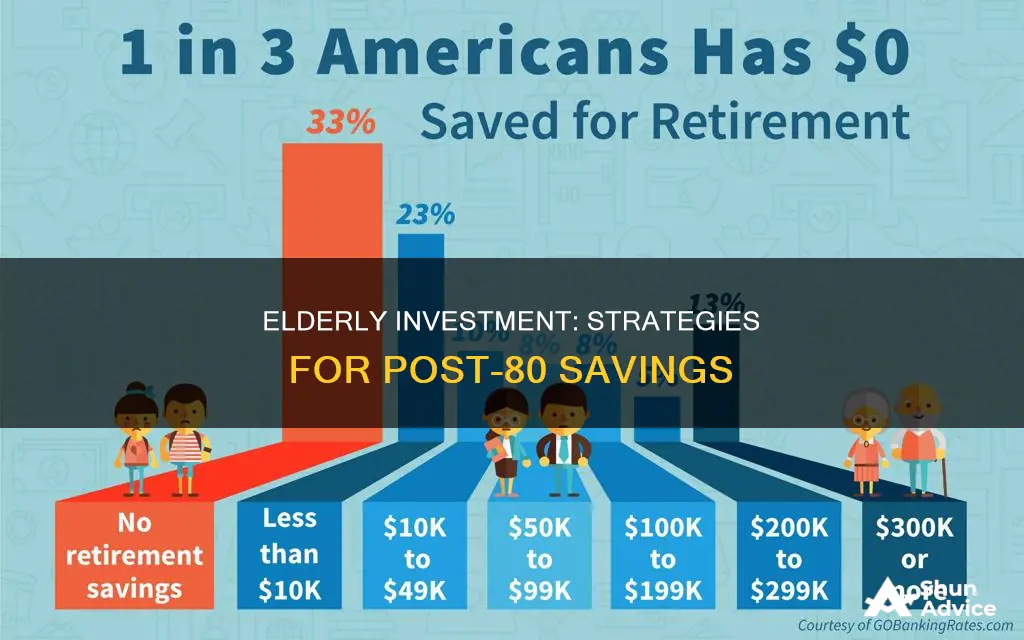
If you're over 80, you'll want to make sure your savings are in a safe place, but also somewhere they can continue to grow. While you might not want to take on too much risk, you also need to consider the impact of inflation and the cost of living. Here are some options for how to invest your savings to make the most of your money in later life.
What You'll Learn

Stocks, bonds, and other assets
When it comes to investing your savings, asset allocation is key. This means diversifying your retirement account across stocks, bonds, and cash. Your age is a primary consideration when managing allocation because the older you are, the less investment risk you can afford to take. As you get closer to retirement age, your risk tolerance decreases, and you can't afford any wild swings in the stock market.
- Review your asset allocation: As you near retirement, your portfolio will gradually shift from more aggressive to more conservative investments. While stocks remain an important part of your retirement portfolio regardless of age, you may want to consider adding a meaningful allocation to bonds and cash. This is because retirees commonly shift their focus from growth to income and stocks that provide dividend income or fixed-income bonds.
- Consider your risk tolerance: Your age is not the only factor to consider when determining your asset allocation. Your innate risk tolerance is also important. If you're comfortable with a more aggressive investment approach, you may be willing to take on more risk. On the other hand, if stability is a priority, you may want to reduce your stock allocation and increase your bond allocation.
- Diversify your holdings: It's important to diversify across different asset classes, such as stocks, bonds, and cash. Within these asset classes, you can further diversify your holdings. For example, you can hold individual stocks or invest in mutual funds or exchange-traded funds (ETFs). You can also diversify your bond holdings by investing in bond funds or varying your holdings across different types of bonds.
- Invest in a target-date fund: If you don't want to actively manage your asset allocation, you can invest in a target-date fund. This is a mutual fund that holds multiple asset classes and gradually moves towards a more conservative allocation as the target date (usually your planned retirement year) approaches.
- Seek professional advice: Consult a trusted financial advisor or planner to help you develop an investment strategy that takes into account your specific circumstances, risk tolerance, and retirement goals. They can assist you in determining the right mix of stocks, bonds, and other assets for your portfolio.
- Consider other retirement accounts: In addition to investing in stocks and bonds, explore other retirement accounts such as a Roth IRA or 401(k). These accounts offer tax benefits and can provide a steady source of income during retirement.
Remember, investing after age 80 is about preserving your capital and generating income to support you through retirement. It's important to regularly review your portfolio and make adjustments as needed to ensure your investments align with your risk tolerance and financial goals.
Will Lear Investment: Navigating the Market's Ever-Changing Landscape
You may want to see also

Safe investments with low risk and low returns
When it comes to investing after age 80, retirees commonly shift their focus from growth to income and stocks that provide dividend income or fixed-income bonds. Most individuals will also collect Social Security benefits and perhaps a company pension.
- Money market accounts: These accounts offer a modest return on your money, and you can find the highest-yielding options by searching online. Money market accounts are government-insured (up to a certain limit), so your money is always safe and protected.
- High-yield savings accounts: Similar to money market accounts, these also offer a modest return with the added benefit of high liquidity. You can withdraw money whenever needed, and your principal amount remains safe.
- Short-term certificates of deposit (CDs): CDs are considered loss-proof as long as you don't withdraw the money early. With interest rates rising, short-term CDs can be a good option, and you can reinvest once the term ends.
- Series I savings bonds: These are low-risk bonds that adjust for inflation, protecting your investment. The interest rate on these bonds is adjusted semi-annually based on the inflation rate, ensuring your investment keeps up with rising prices.
- Treasury bills, notes, bonds, and TIPS: These are highly liquid securities issued by the US Treasury and can be bought and sold directly or through mutual funds. They are considered low-risk, and their market is the largest and most liquid in the world.
- Dividend-paying stocks: While stocks are generally riskier, dividend-paying stocks are considered safer than high-growth stocks as they pay cash dividends, limiting their volatility.
- Fixed annuities: These are popular for retirement planning and provide a guaranteed income and return, giving you financial security. Annuities can also offer tax-deferred growth and additional benefits like death benefits.
It's important to remember that low-risk investments may not offer high returns, and there is still a possibility of losing purchasing power over time due to inflation.
The Future: Invest in AI Now
You may want to see also

How to avoid cognitive decline when managing finances
While some cognitive decline is a normal part of ageing, it can become a serious issue when it starts to interfere with daily tasks, such as managing finances. To avoid this, there are several steps you can take.
Firstly, it is important to be aware of the signs of cognitive decline. This could include things like forgetting to pay bills, difficulty with common financial skills like counting change or writing a cheque, or reports of unusual purchases or withdrawals. If you notice any of these signs in yourself or a loved one, it's important to seek help early on.
One way to prepare for potential cognitive decline is to complete a durable power of attorney for financial matters (DPOAF). This allows you to authorise another person or entity, such as a family member or lawyer, to make financial decisions on your behalf if you become incapacitated. It's also a good idea to seek help from a qualified legal or financial advisor to ensure your finances are in order and that your wishes will be carried out.
Additionally, maintaining social connections and engaging in mentally stimulating activities can help to reduce the risk of cognitive decline. This could include socialising with friends and family, learning a new hobby or skill, or doing puzzles or crosswords to keep your brain active.
Finally, automating your finances as much as possible can help reduce the risk of errors or missed payments. This could include setting up direct deposits, automatic bill payments, or overdraft protection on your bank account. By putting these measures in place, you can help ensure that your finances remain secure even if your cognitive abilities start to decline.
Investments: Current Top Performers
You may want to see also

How to choose a financial advisor
Step 1: Identify your financial needs
Before you start looking for an advisor, reflect on what you want to achieve. Financial advisors provide a range of services, so it's good to know what you need help with. Some advisors may specialise in particular areas, such as debt management or investment advice, while others may offer holistic help. Ask yourself: do you need budgeting help, tax advice, or investment guidance?
Step 2: Understand the types of financial advisors
Financial advisors go by many names, including investment advisors, brokers, certified financial planners, financial coaches, and portfolio managers. Some of these titles aren't tied to specific credentials, so don't assume that impressive-sounding titles equate to specific training or qualifications.
Fee-only fiduciary financial advisors have a fiduciary duty to their clients, meaning they are legally obligated to act in their client's best interest. They are paid directly by you and not through commissions for selling certain products.
Step 3: Review the range of options
Financial advisors are available in-person and online. Robo-advisors, for example, are digital services offering simplified, low-cost investment management. Online financial planning services are the next step up, offering virtual access to human financial advisors. Traditional financial advisors meet with you in person and can help with all your financial planning needs.
Step 4: Consider how much you can afford to pay
Financial advisors cater to every budget. Robo-advisors are usually the cheapest option, charging around 0.25% of your account balance per year. Online financial planning services typically cost less than traditional advisors but more than robo-advisors. Traditional financial advisors often charge about 1% of your assets under management and may also require a high minimum balance.
Step 5: Vet the financial advisor's background
Always verify an advisor's credentials and experience. You can research their background by looking up their Form ADV and reviewing their employment record on FINRA's BrokerCheck website.
Step 6: Hire the financial advisor
If you're happy with a particular advisor's background and are confident they're a good match, it's time to start working with them. The hiring process will vary, but it usually involves an initial consultation, the advisor providing an engagement letter, and then the advisor gathering information on your financial situation.
Smart Ways to Invest $50,000
You may want to see also

How to calculate your net worth
When it comes to investing after the age of 80, the focus is typically on generating income and preserving capital. Here are some general guidelines and strategies for investing at this stage of life:
- Focus on Income-Generating Investments: At this stage, it's important to prioritize investments that provide a steady income, such as dividend-paying stocks or fixed-income bonds.
- Consider Annuities: Annuities can provide a guaranteed income stream for life, which can be attractive for those looking for stable cash flow in retirement.
- Maintain a Conservative Portfolio: As people age, it's generally advisable to reduce the risk in their investment portfolios. This means allocating a larger portion of your portfolio to less risky assets like bonds and cash, while still maintaining some exposure to stocks for potential growth.
- Review and Adjust Your Asset Allocation: Work with a financial advisor to ensure your investment portfolio aligns with your risk tolerance, time horizon, and income needs.
- Take Required Minimum Distributions (RMDs): If you have tax-advantaged retirement accounts like 401(k)s or traditional IRAs, you are typically required to start taking RMDs by a certain age (usually 72 or 73). Failing to take RMDs on time can result in significant penalties.
Now, let's shift our focus to understanding and calculating your net worth:
Net worth is a financial concept that represents an individual's or entity's overall financial position. It is calculated by subtracting all liabilities (debts and obligations) from all assets (items of value owned). Here's a step-by-step guide to calculating your net worth:
- Identify Your Assets: Begin by making a comprehensive list of all your assets. This includes items such as cash, savings and investment accounts, real estate, vehicles, stocks, bonds, and any other valuables you own.
- Determine Your Liabilities: Next, make a list of all your liabilities, which are essentially your debts and financial obligations. This includes credit card debt, mortgage, student loans, car loans, outstanding bills, and any other money owed to another person or entity.
- Calculate the Value of Your Assets and Liabilities: For each item on your lists, assign a monetary value. For assets like savings and investment accounts, use the current balance. For items like real estate and vehicles, use their current market value. For liabilities, use the outstanding balance or amount owed.
- Subtract Liabilities from Assets: Once you have the total value of your assets and the total value of your liabilities, simply subtract the liabilities from the assets. The resulting number is your net worth.
Understanding Your Net Worth:
Net worth can be positive or negative, indicating whether your assets exceed your liabilities or vice versa. A positive and increasing net worth is generally considered a sign of good financial health, while a decreasing net worth may be cause for concern. Here are a few additional points to keep in mind:
- Income vs. Net Worth: It's important to distinguish between income and net worth. A person can have a high income but a low net worth if they spend most of their earnings. Conversely, individuals with modest incomes can build significant net worth through prudent saving and investing.
- Assets and Liabilities Over Time: Your net worth is not static; it can change over time as your assets and liabilities fluctuate. For example, as you pay off a mortgage, your liabilities decrease, potentially increasing your net worth.
- Tracking Net Worth Over Time: Calculating your net worth at regular intervals can help you track your financial progress. It provides a snapshot of your financial position and can help you make informed decisions about saving, investing, and debt management.
- Comparing Net Worth: While it can be interesting to compare your net worth to averages or benchmarks, remember that net worth is highly dependent on individual circumstances, including age, career, lifestyle, and life events.
In summary, calculating your net worth involves taking inventory of your assets and liabilities, determining their values, and then subtracting the latter from the former. This calculation provides a valuable metric for understanding your financial health and can guide your financial decisions as you continue investing your savings.
Retirement Investment Options: Exploring the Best Paths for Your Golden Years
You may want to see also
Frequently asked questions
At this age, it is important to focus on financial sustainability and have clear retirement goals. While stocks are still important, a diverse portfolio that includes cash, equities, and bonds is recommended. The goal is to earn a rate of return that will last throughout your lifetime, so it is advised to take on only as much risk as is necessary.
The old rule of thumb was to subtract your age from 100 to determine the percentage of your portfolio that should be in stocks. For example, if you are 70, 30% of your portfolio should be in stocks. However, with increased life expectancy, financial planners now suggest using 110 or 120 minus your age, to account for the need to make your money last longer.
Safe and low-risk investment options are generally recommended for seniors. These include high-yield savings accounts, certificates of deposit (CDs), treasury bills, notes, bonds, dividend-paying stocks, and money market accounts. These options offer guaranteed returns with minimal risk.
Treasury bills, notes, bonds, and Treasury inflation-protected securities (TIPS) are considered some of the safest investment options for seniors. While the interest rates may be lower, they come with very little risk.
Real Estate Investment Trusts (REITs) are considered a good option for retired individuals seeking higher returns. They typically offer returns of 2% to 3% and have relatively low risk compared to other investments.







